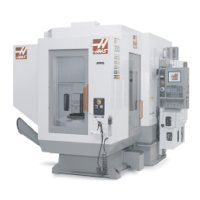30
Introduction
96-8000 rev R June 2007
MEMCMD Run Current MEM
X -3.4372 Y -4.8436
Z 2.8346
O01111 (28-0243 FIXTURE)
;
T1 M06 (1/4 END MILL) ;
S6000 M03 ;
G00 G54 G90 X-1.1553
Y-1.0094 ;
G43 H01 ;
Z0.125 M08 ;
COOL SINGL OPSTP BLK D
High Speed Machining
High speed machining makes it possible for an increase in the removal rate of material, improve surface finish,
and reduce cutting forces which will reduce machining costs and extend the life of the tools.
High Speed Machining is most often required for the machining of smoothly sculpted shapes as is typical of
mold making. The Haas High Speed Machining option increases the amount of lookahead to 80 blocks and
allows full speed (500 inches per minute) blending of feed strokes.
It is important to understand that high speed machining works best with smoothly blended shapes where the
feed rate can remain high through the blend of one stroke to the next. If there are sharp corners, the control will
always need to slow down or corner rounding will occur.
The affect that blending of strokes can have on feed rate is always to slow down motion. The programmed feed
rate (F) is thus a maximum and the control will sometimes go slower than that in order to achieve the required
accuracy.
Too short of a stroke length can result in too many data points. Check how the CAD/CAM system generates
data points to insure that it does not exceed 1000 blocks per second.
Too few data points can result in either “facetting” or blending angles which are so great that the control must
slow down the feed rate. Facetting is where the desired smooth path is actually made up of short, flat, strokes
that are not close enough to the desired smoothness of the path.
High Speed Tooling – The tool holders should be an AT-3 or better with a nylon back-up screw. The toler-
ances maintained in the AT-3 design are the minimum that would be recommended for a high speed process.
The nylon back-up screw increases collet grip on the tool and creates a better seal to aid in coolant transfer.
Use single angle collet chucks and collets for best grip and concentricity. These collet systems are made up of
a long single angle located in the holder. The angle per side should be eight degrees or less for best results.
Avoid double angle collet systems when maximum rigidity and close tolerance are dictated. It is recommended
that minimum engagement of 2/3 of the full length of the bore in the double split single angle collet. However for
better results 3/4 to full engagement is preferred if possible.
Auxiliary Filter
This 25-micron #2 bag-type filter system removes contamination and minute particles from the coolant before
they can be recirculated through the coolant pump. The filter is mandatory for machines equipped with through-
spindle coolant when machining cast iron, cast aluminum and other abrasive materials, and may be used on
non-TSC machines as well.

